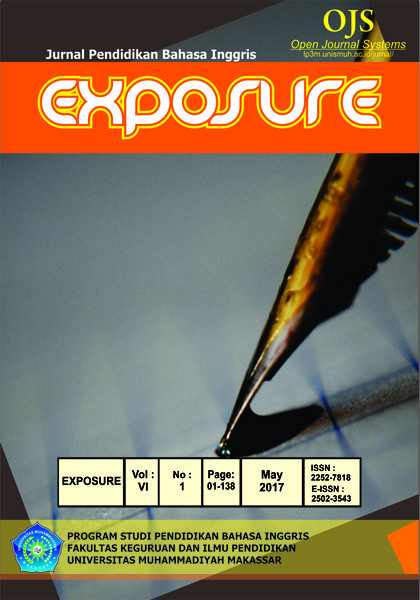THE STUDENTS’ WRITING PROFICIENCY IN DESCRIPTIVE PARAGRAPH WITH PERSONAL PHOTOGRAPH
DOI:
https://doi.org/10.26618/exposure.v6i1.1060Abstract
The objective of the research was intended to find out the students improvement of writing the descriptive paragraph in term of organization and content; to explain whether or not using personal photograph can increase the students’ writing in the descriptive paragraph. This research used Classroom Action Research that consisted of two cycles. The research population was the second-grade students of SMA Negeri 1Cendanain academic 2014/2015. The sample of this research consisted of 23 students. The instrument used for measuring the students' ability scoring the student was a written test. The findings of the research were (1) the students’ sentence organization achievement was increased 3,6% from pretest to cycle 1 and was increased 8,8% from cycle 1 to cycle 2. (2) the students’ sentence content achievement was increased 4,3% from pretest to cycle 1 and was increased 8,9% from cycle 1 to cycle 2. From the finding of the research, it indicated that using personal photograph can increase the students’ writing proficiency.
References
Alexander, Francie. 1990. Writing Assessment Handbook. California: California Department of Education.
Caudery, T. 1990. ‘The validity of timed essay tests in the assessment of writing skills’. ELT Journal 44/2: 122–32.
Dalle, Basri. 2010. Fundamentals of Research Methodology. Makassar: UniversitasMuhammadiyah Makassar
Damayanti, Irma. 2009. Increasing the students’ writing skill through dyadic essay confrontation technique. Skripsi. Makassar: Fakultas Keguruandan Ilmu Pendidikan UniversitasMuhammmadiyah.
Fennier, Andreas. 1994 UnsurUtamaPhotography Semarang: Sahara Price Semarang .
Graham, Steve, and Dolores Perin. 2007. Writing Next. Washington, DC: Alliance for Excellent Education
Hasan, Yunus. 2009. Increasing the students’ writing proficiency through Think-Talk-Write method. Skripsi. Makassar: FakultasKeguruan dan Ilmu Pendidikan Universitas Muhammadiyah Makassar.
Jacob, et. al. 1981. Testing ESL Composition, A Practical Approach. Massachusets: Newburg House.
Jack, Breton. 1982. A plan for writing.Canada: Rinehart and Winston Company
Johari , Abdul Rajab . 1999 .Extensive Reading.Makassar .
Latief, Adnan. 2009. PenelitianTindakanKelasPembelajaranBahasaInggris. KaryaTulisIlmiah. Malang: Fakultas Sastra Universitas Negeri Malang
Lennon, Johnn. 1992. The Writing Process: A Concise Rhetoric: Fourth Edition, New York: Harper Collins Publisher.
Littell, McDougal. 2004. Basic Skills in English. States of America: McDougal, Littell and Company.
Locates ,Graight N and Atkinson, Prancisagy. 1984. Media and Technology For Education and Training. Colombus : Charles E . Merril Publishing Company. A Bell and Howell Company.
Need, Elizabeth Cowan and Kiefer, Kate. 1990. Writing Brief: Third Edition. Glenview: Scoot, Foresman Company.
Oshima, Alice and Ann Hogue. 1997. Introduction to Academic Writing. London and New York: Longman Group UK Limited.
Scott, V.M. (1996). Rethinking foreign language writing. Boston, M.A.: Heinle&Heinle.
Saraka , 1988 . From Paragraph to Essay .Jakarta .Depdikbud .
Tiro, Muhammad Arif and Baharuddin Ilyas.2002. StatistikaTerapan untuk Ilmu Ekonomi dan Ilmu Sosial. Makassar: Andira Publisher
Subyakto, Sri Utari. 1993. Metodologi Pengajaran Bahasa. Jakarta : PT Gramedia Pustaka Utama
Syam, U. K., & Sangkala, I. (2014). Information Transfer Technique in Teaching Writing. Exposure: Jurnal Pendidikan Bahasa dan Sastra Inggris, 3(1), 97-106.
Walker, Robin, and Carmen perezRiu. 2008. Coherence Assessment of Writing Skill. ELT Journal 62⁄1. 18-27.
Yarber, Robert . 1980. Writing For College. Boston: Harper Collins Publisher
Downloads
Published
Issue
Section
License
Authors who publish with this journal agree to the following terms:
In order to assure the highest standards for published articles, a peer review policy is applied. In pursue of the compliance with academic standards, all parties involved in the publishing process (the authors, the editors and the editorial board and the reviewers) agree to meet the responsibilities stated below in accordance to the Journal publication ethics and malpractice statement.
Duties of Authors:
- The author(s) warrant that the submitted article is an original work, which has not been previously published, and that they have obtained an agreement from any co-author(s) prior to the manuscript’s submission;
- The author(s) should not submit articles describing essentially the same research to more than one journal;
- The authors(s) make certain that the manuscript meets the terms of the Manuscript Submission Guideline regarding appropriate academic citation and that no copyright infringement occurs;
- The authors(s) should inform the editors about any conflict of interests and report any errors they subsequently, discover in their manuscript.
Duties of Editors and the Editorial Board:
- The editors, together with the editorial board, are responsible for deciding upon the publication or rejection of the submitted manuscripts based only on their originality, significance, and relevance to the domains of the journal;
- The editors evaluate the manuscripts compliance with academic criteria, the domains of the journal and the guidelines;
- The editors must at all times respect the confidentiality of any information pertaining to the submitted manuscripts;
- The editors assign the review of each manuscript to two reviewers chosen according to their domains of expertise. The editors must take into account any conflict of interest reported by the authors and the reviewers.
- The editors must ensure that the comments and recommendations of the reviewers are sent to the author(s) in due time and that the manuscripts are returned to the editors, who take the final decision to publish them or not.
Authors are permitted and encouraged to post online a pre-publication manuscript (but not the Publisher’s final formatted PDF version of the Work) in institutional repositories or on their Websites prior to and during the submission process, as it can lead to productive exchanges, as well as earlier and greater citation of published work (see The Effect of Open Access). Any such posting made before acceptance and publication of the Work shall be updated upon publication to include a reference to the Publisher-assigned DOI (Digital Object Identifier) and a link to the online abstract for the final published Work in the Journal.

